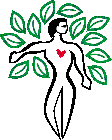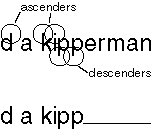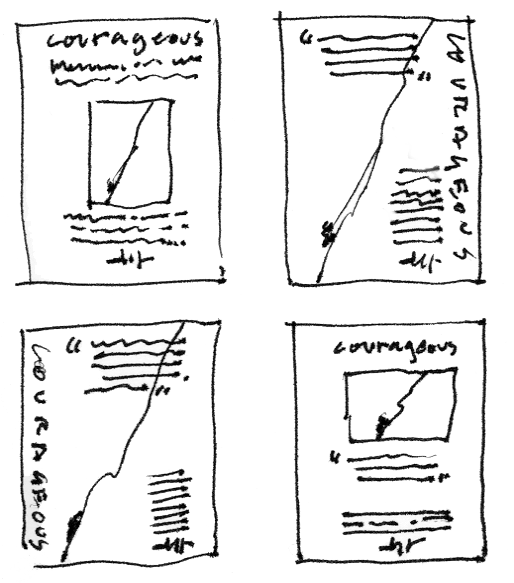
San Diego
Jewish Academy
Art
Identifying
Self
|
|
San Diego
Jewish Academy |
To the question, "what does this have to do with art?" The answer lies in my belief that artists represent the mirror of society and in order to truly reflect societies' successes, failures, foibles, and idiosyncrasies we must first look inward.
The process that allows us to see, think, create, and express, regardless of the endeavor, remains very similar. I use the term creative process, but semantics aside, the steps start with background research and lots of questions, a journey through the revision and editing process, and arrive in a final action. Throughout the process questions abound, some answered some promoting more questions, but always leading toward some end result. When allowed to flow, creativity becomes nothing more than following a systematic process, allowing random connections to take place, and using your intuition to develop unique solutions.
So, to the question, "what does this have to do with art?" This project provides the beginning tools for us to see, think, create, and express.
Phase 1 - Identify ten adjective descriptors
Phase 2 - From phase 1, select the three best adjective descriptors
Phase 3 - Two thumbnails for each descriptor that include indicators:
Phase 4 - On a piece of paper approximately 9" by 12" take one of the three words and:
Total (105 points)
You must include all drafts from each phase with your final project.
The way you present you final project should support what you want us to think about you, e.g., the descriptor, organized, should have a well organized presentation that might include a title page, table of contents, or other elements that show organization.
Top
Steps of the Creative
Process
Concept Development
(research, notes, brainstorming, sketching, prewriting, graphic
organizers)
Draft Phase
(organize research and create coherent product) Ready for Response
Revision and Editing Phase
(further develop and refine, get more response,
proofread)
Final
(tight and as perfect as possible within timeline and parameters)
Ready for Assessment
Top
Characteristics
For some help on how to think about yourself, you might check out the following test sites (I wouldn't change my life because of these, but if nothing else, you may get entertained):
Personality tests - http://www.2h.com/personality-tests.html - provides of 20 different types of tests.
IQ and personality tests - http://www.davideck.com/online-tests.html - provides tests in the following areas: personality, IQ, love, health, career, and others.
UniverstiyofLife.com - http://universityoflife.com/serious.htm - Includes the following types of tests: IQ, EQ, personality, health, computer, career-education, and more.
Top
|
|
|
|
Because and other vague responses have never constituted acceptable answers to the question, why should I believe you? This project uses the creative process to develop evidence to minimize subjectivity and enhance clear, objective, and tangible evidence. You may not agree with me, but you cannot refute my evidence.
The process includes, gathering possible evidence, organizing and making sense of the evidence, revising and editing the evidence, and then putting the evidence into a final form, in short the creative process.
Examples:
Methodical - When I approach a project, I use a process that affords me structure to work toward my goal. As a specific example, I am creating a book of my family history. I started by collecting photos, articles, essays, and other research material in my possession and then asked my parents and brothers for similar materials. I scanned, typed, and organized everything so that I could develop a design format. Once I experimented with possible formats I proceeded to input the materials. As I would encounter functional challenges or opportunities I revised and edited the material and format. I worked on the book for four weeks during August and in its most current version consists of 171 pages that span a time period from 1874 to 2002.
or for more mundane examples of evidence:
Remember: Start with an initial idea - ask questions, gather information - ask more questions, organize the information - ask even more questions, revise and edit until you have run out of questions or until the deadline dictates that you finalize your project and then, just do it.
Start with what you know.
In the case of developing your signature, start with different type variations of your name. The possibilities can get out of control, so keep it simple, unless of course you on a quest for the holy grail.
As I mentioned above you can get really carried away with possible variations, which is fine, but at some point you have to produce.
Whenever you embark upon solving a visual-communication problem—or any problem, for that matter—you may fall prey to the usual response of looking for the answer. This habitual, knee-jerk reaction is the great pitfall of creative thinking and leads to hackneyed solutions that reside in the known. When you look for answers, you are mining the area of the brain that holds what you already know, and that, in itself, negates the creative act.
Curiously enough, if you move in the opposite direction and look not for answers but for questions, your possibilities can take root. For it is here and only here that new and innovative solutions arise. Resistance to finding the appropriate question lies in the fear of moving into the unknown. We are uncomfortable in this area. Fear of failure looms over us. We all succumb to the impulse of wanting immediate results, which the realm of answers provides.
Finding a meaningful question that ignites interest creates the condition that permits new solutions to arise. In essence, when you move into a state of questioning, creativity can flourish. This, in turn, leads to wonder, a state of openness in which new impressions take form. (http://www.cmykmag.com/magazine/issues/current/articles/feature/feature.html)
What do I want my signature to say about me?
What overall mood/attitude do I want my signature to express?
When and on what am I going to use my signature?
What characters visually stand out?
Again, you could play this game for awhile, but problem solving requires you to solve the problem in a timely manner, so move on.
Douglas A Kipperman
douglas a kipperman
d a kipperman
dk
Once you have selected possible variations "play" with them.
Look for the exceptions, the characters that stand out.
Use your natural writing motion to determine the flow, dimension, stress, angle, direction, etc. of the line to address the questions asked above.
Explore, experiment, play, and don't get trapped into doing what you always do.
Push yourself to try new possibilities. What may not feel natural at first, will after you have worked with it for a while.
Example:
This is one possible solution based on the variation to
the left, but many more possibilities exist, and by the way,
this is not my signature.
Top


Thumbnails represent scaled down versions of the final product. For this project where the final product size is 9" x 12", thumbnails might be approximately 2" x 2-2/3", large enough to show some detail, but small enough to work quickly.
Thumbnails enable you to make decisions about how you wish to present your content without investing a lot of time.

Make sure your thumbnails have the same proportions as the final product.
Include all of the elements - images, text, and other graphic devices that will make up the final product.
Keep in mind that even though thumbnails help you make decisions, changing scale to full size often changes the final layout.
Please don't get lazy with your exploration. Time spent
in the creative process leads to much more satisfactory, sometimes
even brilliant, results.
Remember to enjoy the journey.
E-Mail Doug at mrdoug@aznet.net
|
|
Melissa and I would like to |